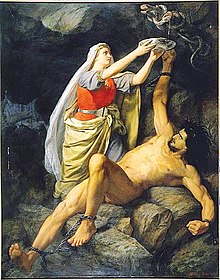Sigyn(Old Norse"(woman) friend of victory"[1]) is adeityfromNorse mythology.She is attested in thePoetic Edda,compiled in the 13th century from earlier traditional sources, and theProse Edda,written in the 13th century bySnorri Sturluson.In thePoetic Edda,little information is provided about Sigyn other than her role in assisting her husbandLokiduring his captivity. In theProse Edda,her role in helping Loki through his time spent in bondage is reiterated, she appears in variouskennings,and her status as a goddess is mentioned twice. Sigyn may appear on theGosforth Crossand has been the subject of an amount of theory and cultural references.

Attestations
editSigyn is attested in the following works:
Poetic Edda
editIn stanza 35 of thePoetic EddapoemVöluspá,avölvatellsOdinthat, amongst many other things, she sees Sigyn sitting very unhappily with her bound husband,Loki,under a "grove ofhot springs".[2]Sigyn is mentioned a second (and final) time in the ending prose section of the poemLokasenna.In the prose, Loki has been bound by the gods with the guts of his sonNari,his sonVáliis described as having been turned into a wolf, and the goddessSkaðifastens a venomous snake over Loki's face, from whichvenomdrips. Sigyn holds a basin under the dripping venom. The basin grows full, and she pulls it away, during which time venom drops on Loki, causing him to writhe so violently that earthquakes occur that shake the entire earth.[3]
Prose Edda
editSigyn appears in the booksGylfaginningandSkáldskaparmálin theProse Edda.InGylfaginning,Sigyn is introduced in chapter 31. There, she is introduced as being married to Loki, and that they have a son by the name of "Nari or Narfi".[4]Sigyn is mentioned again inGylfaginningin chapter 50, where events are described differently than inLokasenna.Here, the gods have captured Loki and his two sons, who are stated asVáli,described as a son of Loki only, and "Nari or Narfi", earlier described a son of Sigyn and Loki.[5]Váli is changed into a wolf by the gods, and rips apart his brother "Nari or Narfi". The guts of "Nari or Narfi" are then used to tie Loki tothreestones, after which the guts turn to iron, and Skaði places a snake above Loki. Sigyn places herself beside him, where she holds out a bowl to catch the dripping venom. However, when the bowl becomes full she leaves to pour out the venom. As a result, Loki is again described as shaking so violently that the planet shakes, and this process repeats until he breaks free, settingRagnarökinto motion.[5]
Sigyn is introduced as a goddess, anásynja,in theProse EddabookSkáldskaparmál,where the gods are holding a grand feast for the visitingÆgir,[6]and inkenningsfor Loki: "husband of Sigyn",[7]"cargo [Loki] of incantation-fetter's [Sigyn's] arms",[8]and in a passage quoted from the 9th-centuryHaustlöng,"the burden of Sigyn's arms".[9]The final mention of Sigyn inSkáldskaparmális in the list of ásynjur in the appendedNafnaþulursection, chapter 75.[10]
Archaeological record
editThe mid-11th centuryGosforth Crosslocated inCumbria,England,has been interpreted as featuring various figures from Norse mythology. The bottom portion of the west side of the cross features a depiction of a long-haired female, kneeling figure holding an object above another prostrate, bound figure. Above and to their left is a knotted serpent. This has been interpreted as Sigyn soothing the bound Loki.[11]
Scholastic reception
editWhile the nameSigynis found as a female personal name in Old Norse sources (Old Norsesigrmeaning 'victory' andvinameaning 'female friend'), and though in surviving sources she is largely restricted to a single role, she appears in the 9th century skaldic poemHaustlöngfrompagantimes, written by theskaldÞjóðólfr of Hvinir.Due to this early connection with Loki, Sigyn has been theorized as a god dating back to an older form ofGermanic paganism.[12]
Modern influence
editThe scene of Sigyn & Loki has been depicted on a number of paintings, including "Loke och Sigyn" (1850) byNils Blommér,"Loke och Sigyn" (1863) byMårten Eskil Winge,"Loki och Sigyn (1879) byOscar Wergeland,and the illustration "Loki und Sigyn; Hel mit dem Hunde Garm" (1883) by K. Ehrenberg.[12]Various objects and places have been named after Sigyn in modern times, including the Norwegian stiff-strawwinter wheatvarietiesSigyn IandSigyn II,[13]aMarvel Comicscharacter (1978) of thesame name,[14]the Swedish vesselMS Sigyn,which transports spent nuclear fuel in an allusion to Sigyn holding a bowl beneath the venom to spare Loki,[15]and the antarcticSigyn Glacier.[16]
Notes
edit- ^Orchard (1997:146).
- ^Larrington (1998:8).
- ^Larrington (1998:95–96).
- ^Byock (2006:31).
- ^abByock (2006:70).
- ^Faulkes (1995:59).
- ^Faulkes (1995:76).
- ^Faulkes (1995:83).
- ^Faulkes (1995:87)
- ^Faulkes (1995:157).
- ^Orchard (1997:13).
- ^abSimek (2007:284).
- ^Belderok (2000:95).
- ^"Sigyn".Marvel Directory.Marvel Character, Inc.Archivedfrom the original on 19 September 2008.Retrieved29 August2008.
- ^"Båten som fraktarkärnbränslet"(in Swedish). Sveriges Radio. Archived fromthe originalon 14 February 2009.Retrieved28 August2008.
- ^"Sigyn Glacier".Geographic Names Information System.U.S. Geological Survey.Archivedfrom the original on 2 May 2023.Retrieved29 August2008.
References
edit- Belderok, Bob. Mesdag, J. Mesdag, Hans. Donner, Dingena A. (2000).Bread Making Quality of Wheat: A Century of Breeding in EuropeArchived2 May 2023 at theWayback Machine.Springer.ISBN0-7923-6383-3
- Byock, Jesse (Trans.) (2006).The Prose Edda.Penguin Classics.ISBN0-14-044755-5
- Faulkes, Anthony (Trans.) (1995).Edda.Everyman.ISBN0-460-87616-3
- Larrington, Carolyne (Trans.) (1999).The Poetic Edda.Oxford World's Classics.ISBN0-19-283946-2
- Orchard, Andy (1997).Dictionary of Norse Myth and Legend.Cassell.ISBN0-304-34520-2
- Simek, Rudolf (2007) translated by Angela Hall.Dictionary of Northern Mythology.D.S. Brewer.ISBN0-85991-513-1